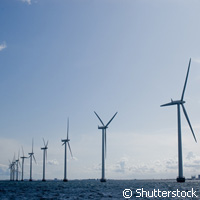EU must invest more in wind power if 20MW turbines to become reality
Giant 20 megawatt (MW) wind turbines are feasible and could provide a cost-effective way of expanding Europe's offshore wind capacity and providing cheaper electricity, according to a report from the EU-funded UPWIND ('Integrated wind turbine design') project. The UPWIND project received EUR 14.5 million from the 'Sustainable development, global change and ecosystems' Thematic area of the Sixth Framework Programme (FP6) and the study was published at the European Wind Energy Association's (EWEA) annual event in Brussels, Belgium. The EWEA forecasts that wind energy will meet 26-34 per cent of Europe's electricity demand by 2030, with almost as much electricity coming from offshore turbines as from those onshore. This latest report from UPWIND agrees that 20 MW machines could be one way of reaching these levels of production by providing several times more electricity at lower costs than that produced by today's turbines. Indeed, while the report believes that such technology is possible, it also warns that producing such machines would be complicated. It states that it would not be possible simply to upscale the technology used to produce the 5 MW turbines that are already in operation. Instead, it says that a new, innovative, tailored design would be required to make 20 MW turbines work. 'UPWIND found that making a 20 MW machine is not as simple as just upscaling today's 5 MW turbines,' commented Jos Beurskens from the NETHERLANDS' Energy Research Centre (ECN), who led the project along with the UPWIND Coordinator Peter Hjuler Jensen from the Danish Technical University Risø DTU. He said that the project had helped identify how such large turbines could be constructed. 'We identified key innovations to the design, materials and way the turbine is operated,' noted Mr Beurskens. Mr Beurskens added that with this in mind, although significant research is still needed, he believes 20 MW turbines could be in operation by 2020. 'Intuitively, I believe we'll see the 20 MW turbines used within 10 years,' he said. However, he supported Mr Kjaer's calls for more funding, adding that his scenario would only be feasible providing these large-scale turbines are 'the cheapest option'. Among the main innovations UPWIND suggests for a 20 MW wind turbine is the need to change the layout of a wind farm by lowering the power output of the first row of turbines to allow for higher overall wind farm efficiency. Moreover, the report claims that the future smart wind turbine would be able to adapt its position and the pitch of its blade to local wind conditions. The study also mentions a variety of ways the blades should be changed to improve efficiency and make them easier to transport. Finally, it highlights how technological advances would allow future wind turbines to be better maintained than the current generation of machines.For more information, please visit: European Wind Energy Association (EWEA):http://www.ewea.orgUPWIND:http://www.upwind.euThe UPWIND report:http://www.ewea.org/fileadmin/ewea_documents/documents/upwind/21895_UpWind_Report_low_web.pdf
Countries
Belgium, Denmark, Netherlands



